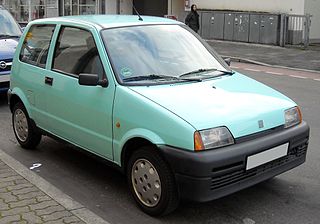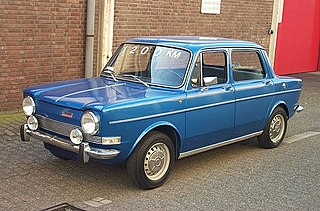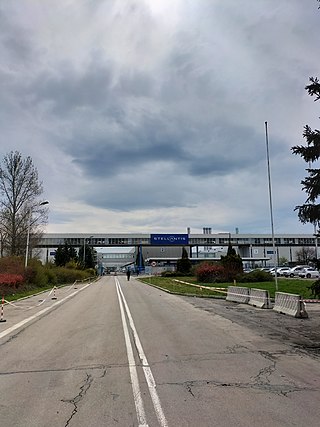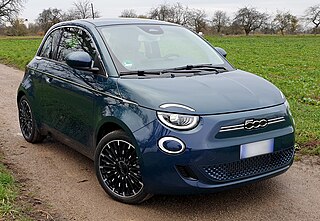
Abarth & C. S.p.A. is an Italian racing- and road-car maker and performance division founded by Italo-Austrian Carlo Abarth in 1949. Abarth & C. S.p.A. is owned by Stellantis through its Italian subsidiary. Its logo is a shield with a stylized scorpion on a yellow and red background.

The Ford Ka is a small car manufactured by Ford Motor Company from 1996 to 2016 as a city car and from 2014 to 2021 as a subcompact car. It entered its second generation in 2008, produced by Fiat in Tychy, Poland. A third generation was introduced in 2016.

The Fiat Uno is a supermini manufactured and marketed by Fiat. Launched in 1983, the Uno was produced over a single generation in three and five-door hatchback body styles until 1995 in Europe — and until 1 January 2014, in Brazil. Designed by Giorgetto Giugiaro of Italdesign, the Uno strongly recalled the high-roof, up-right packaging of Giugiaro's 1978 Lancia Megagamma concept, in a smaller configuration.

The Fiat 500 is an economy / city car that was manufactured and marketed by Fiat Automobiles from 1957 until 1975. It was sold as a two-door semi-convertible or saloon car and as a three-door panel van or estate car.

The Fiat 126 is a four-passenger, rear-engine, city car manufactured and marketed by Fiat over a twenty-eight year production run from 1972 until 2000, over a single generation. Introduced by Fiat in October 1972 at the Turin Auto Show, the 126 replaced the Fiat 500, using major elements from its design. A subsequent iteration, marketed as the 126 Bis, used a horizontally oriented, water-cooled engine and featured a rear hatchback.

The Fiat Panda is a city car manufactured and marketed by Fiat since 1980, currently in its third generation. The first generation Panda, introduced in 1980, was a two-box, three-door hatchback designed by Giorgetto Giugiaro and Aldo Mantovani of Italdesign and was manufactured through 2003 — receiving an all-wheel drive variant in 1983. SEAT of Spain marketed a variation of the first generation Panda under license to Fiat, initially as the Panda and subsequently as the Marbella (1986–1998).

The Fiat Punto is a supermini car (B-segment) produced by the Italian manufacturer Fiat from 1993 to 2018, spanning over three generations. The third generation of the car was marketed between 2005 and 2009 as the Grande Punto, and between 2009 and 2012 as the Punto Evo, until the single-word Punto name was reintroduced. As of May 2013, nearly nine million units had been sold globally.

The Fiat Cinquecento is a front engine front-wheel-drive, four passenger, three door hatchback city car, manufactured and marketed by Fiat from 1991 to 1998 over a single generation.

The Fiat Stilo is a small family car available as a three- and a five-door hatchback, as well as an estate, produced by Italian automaker Fiat. The Stilo hatchbacks were presented in March 2001, at the Bologna Motor Show and launched in October 2001 to replace the Fiat Bravo/Brava, with the Stilo Multi Wagon following in January 2003.

The Fiat Strada is a supermini coupé utility produced by the Italian manufacturer Fiat since 1998. It is based on Fiat's world car "project 178", the Palio. It is produced by Fiat Automóveis in Brazil, and has been marketed worldwide, excluding the United States and Canada. In Europe the Strada was sold by Fiat Professional division.

The Fiat 600 is a small, rear-engined city car and economy family car, made by Italian carmaker Fiat from 1955 to 1969 — offered in two-door fastback sedan and four-door Multipla mini MPV body styles. The 600 is considered a pop icon of the Italian economic miracle, and the three-row seating Multipla, though diminutive and odd-looking, is seen as one the first mass-produced minivans.

The FIRE is a series of automobile engines from Fiat Powertrain Technologies, built in FCA's Termoli, Betim and also in Dundee, MI plants. It was designed by Italian design firm Rodolfo Bonetto. It is constructed by robot assembly plants ("Robogate") to reduce costs.

The Fiat 124 Sport Spider is a convertible sports car marketed by Fiat for model years 1966–1985. Designed by and manufactured at the Italian carrozzeria Pininfarina factory, the monocoque, front-engined, rear-drive Sport Spider debuted at the November 1966 Turin Auto Show with styling by Tom Tjaarda.

The Fiat 850 is a small rear-engine, rear-wheel-drive car manufactured and marketed by Italian car manufacturer Fiat from 1964 to 1973.

The Fiat 500 is an A-segment city car manufactured and marketed by the Fiat subdivision of Stellantis since 2007. It is available in hatchback coupé and fixed-profile convertible body styles, over a single generation — with an intermediate facelift in Europe with model year 2016. The 500 is internally designated as the Type 312 by FCA.

The Simca 1000, or Simca Mille in French, is a small, boxy rear-engined four-door saloon, manufactured for 18 years by French automaker Simca, from 1961 to 1978.

The Fiat-Abarth 750 is a compact sporting series of automobiles manufactured by the Italian manufacturing firm Abarth & C. of Turin, Italy in the 1950s and 1960s. The cars used the floorpan and often the bodywork of the Fiat 600 but were fitted with Abarth's modified engines. Abarth also offered a number of bodyworks by other designers for the 750 and its derivatives, most famously Zagato but also Allemano and others.

The Fabryka Samochodów Małolitrażowych, commonly known as FSM, was a Polish automobile factory born from an agreement between the FSO and Fiat in the 1970s for the construction of a new model, the Polski Fiat 126p, Polish version of Fiat 126. For the project a new manufacturing plant was opened in Tychy. The factory also produced until the beginning of the 1980s the FSO Syrena. The FSM brand was active between 1971 and 1992, when it was privatised and Fiat Group took control of it.

FCA Poland S.A. is an automobile factory belonging to Stellantis formed on May 28, 1992, after Fiat acquired Fabryka Samochodów Małolitrażowych (FSM) in Bielsko-Biała and Tychy. At that time, Fiat Auto took over 90% of the company's shares. The takeover of FSM by Fiat has been considered hostile and controversial. The plant has been part of Stellantis since 2021, following the merger of FCA and PSA Group. As of 2020, the facility had 2,500 employees.

The Fiat New 500, also known as the Fiat 500e is a battery-electric car by Italian manufacturer Fiat. The New 500 city car is manufactured at the Mirafiori plant in Turin and is sold alongside the conventionally-powered Fiat 500 (2007), which continues to be manufactured in Tychy, Poland. That 2007 car was used as the basis of a previous BEV Fiat 500e (2013), which was sold only in the United States and had a much smaller range than the New 500. It was scheduled to be launched at the Geneva Motor Show but that event was canceled due to the COVID-19 pandemic. It was unveiled on 4 March 2020 in Milan.





























